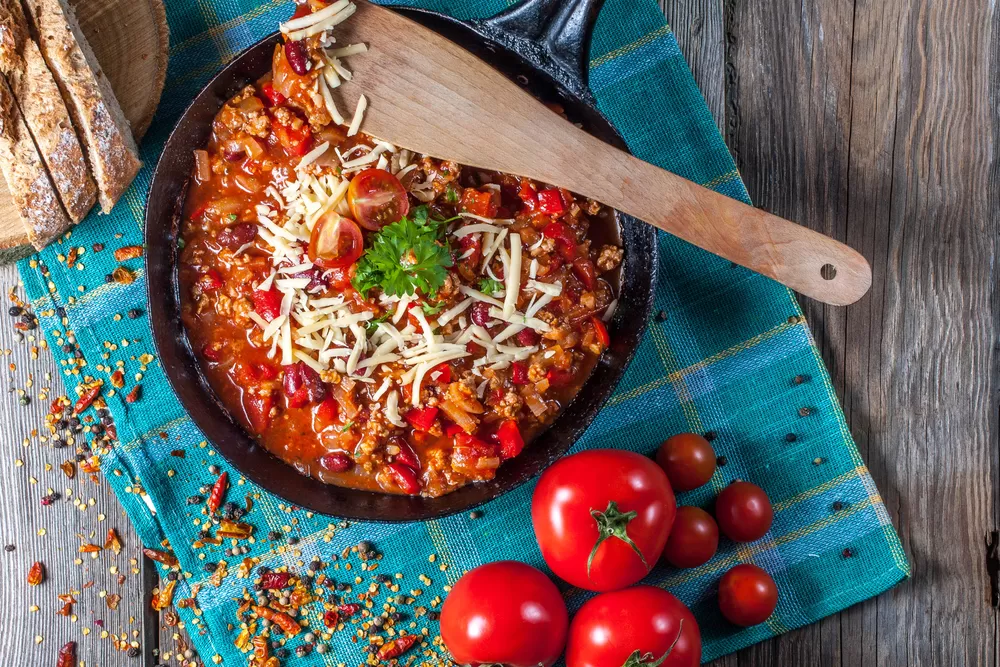Last Updated on 19th June 2023 by
With its impeccable belly-warming qualities, the chilli con carne (or chilli for short) is my favourite Mexican dish. Best of all, you don’t have to prepare small portions every day. You can cook a large pot, store it in the fridge, and enjoy that heavenly dish in the following days!
But the question begs itself, how long does chilli last once cooked? If cooked well, it should stay intact for 3–4 days. If you store it in the freezer, it can last for up to 4–6 months — a fascinating duration for a dish that contains meat, vegetables, and herbs!
Are these durations always guaranteed? How can you know if the chilli goes bad? And most importantly, what factors can accelerate the spoilage process? That’s what I’ll answer in this article. Let’s see!
Table of Contents
First of All, Why Do We Store Cooked Food In the Fridge?
To understand the proper way to store chilli, or any cooked food in general, you should first know what makes them spoil.
As you might already know, everything around us, including the air we breathe, contains different species of bacteria and mould spores. But luckily, these pathogens aren’t numerous enough to cause diseases.
Cooked vs. Uncooked Food
As a start, let’s get into the nitty-gritty of food spoilage. Bacteria and mould spores are all around us, including in the air we breathe. But don’t worry, they aren’t in large enough numbers to cause immediate harm.
The game changes once we cook food. Raw food has defenses against these pathogens, enabling it to stay fresh for a longer period. When we cook food, these natural defenses are broken down, and the food becomes moist — a perfect feast for microbes.
The Danger Zone
The United States Department of Agriculture (USDA) pinpoints a temperature range, known as the “Danger Zone” (40 °F to 140 °F), where these unwanted guests thrive. In this range, bacteria multiply at an alarming rate.
To keep our beloved chilli safe, we should aim for the following storage conditions:
- At or above 140 °F, using appliances like slow cookers or warming trays.
- At or below 40 °F, i.e., inside a refrigerator or freezer.
Remember, if the chilli has to be in the Danger Zone, don’t leave it there for more than two hours. In hotter areas with average temperatures above 90 °F, that window shrinks to just one hour.
So, How Should You Store Your Chilli?
After you cook your chilli, cool it to room temperature before storing it in an airtight container. This process slows down bacterial growth and keeps your food fresh longer. But remember, if you can’t refrigerate the chilli within two hours, it’s best to freeze it.
Here’s a little pro tip for you: regardless of how well you store your chilli, it will always contain some bacteria. The trick lies in controlling their growth. In the refrigerator (below 40 °F), bacterial growth slows, making your chilli good for 3–4 days. On the other hand, freezing (below 0 °F) halts bacterial growth, extending your chilli’s life for up to 4–6 months!
How to Know If Your Chilli Has Gone Bad?
Unfortunately, your chilli can go bad even if you follow all the storage recommendations to the letter. We can’t exactly predict how bacteria and mould will behave, especially when we can’t maintain accurate temperatures.
So, you should familiarise yourself with the spoilage signs. If you ever spot any of the following signs, discard your chilli immediately, even if the stored amount is too large. You know, it’s better to err on the side of caution when it comes to food poisoning!
Smell
Even though we, as humans, evolved to depend less on our noses, we can still identify rotten food from a distance.
If your chilli smells musty, pungent, rancid, or just a little off, throw it in the trash. And please, do yourself a favour and trust your nose on this one!
Consistency
The byproducts produced by bacteria and mould will seep into the chilli’s stew, making it feel slimy. Also, the hard bits will look either crumpled or fused.
Colour
In the unlikely event that you missed the previous signs, you could never miss this one. After rotting, the chilli’s stew, beans, and beef will change in colour. Initially, they’ll only have a darker shade. But with enough time, they might develop sizeable greenish or whitish spots. As you might already know, those latter colours denote mould infestation.
To ensure optimal safety, I also recommend checking the container’s sides plus the lid’s underside. Because mould spores can fly into the air, they might manifest at these relatively distant locations before appearing in the chilli itself.
Storage Duration
If you’ve been refrigerating your chilli for more than four days, don’t even check for the previous signs — just throw it right away!
That’s All, Folks!
How long can you keep chilli in the refrigerator? It depends on the storage method. If you refrigerate it between 0 °F and 40 °F, you can keep it there for up to four days.
If you want to keep it stored longer, you’ll have to use the freezer. Ideally, it can stay there for up to six months, but you can’t always guarantee optimal taste after that lengthy period.
Remember, for both storage methods to work, you must not leave the chilli for more than 2 hours at room temperature. Also, the storage container should be airtight since air is a major spoiling factor.
Lastly, keep this saying in mind, “When in doubt, throw it out!”
Classic Chilli Con Carne
Ingredients
- 2 tbsp olive oil
- 1 large onion, diced
- 2 cloves garlic, minced
- 1 1b ground beef
- 1 red bell pepper, diced
- 2 cans diced tomatoes
- 2 cans kidney beans, drained
- 1 tbsp chilli powder
- 1 tsp ground cumin
- Cheddar cheese, sour cream, and chopped cilantro for serving (optional)
Instructions
- Heat olive oil in a large pot over medium heat. Add the onion and garlic, cook until softened.
- Add the ground beef to the pot and cook until browned. Drain off any excess fat.
- Stir in the red bell pepper, diced tomatoes, kidney beans, chilli powder, and cumin. Season with salt and pepper.
- Reduce the heat to low, cover the pot, and let it simmer for about 2 hours, stirring occasionally.
- Serve the chili hot, topped with cheddar cheese, sour cream, and cilantro if desired.
Notes
FAQs
Can you eat leftover chili after 7 days?
No, it’s not recommended to eat leftover chili after 7 days. Cooked chili should ideally be consumed within 3-4 days when refrigerated. After this, the risk of food poisoning significantly increases. When in doubt, throw it out!
How long can you keep chili in the refrigerator?
Cooked chili can safely be stored in the refrigerator for 3-4 days. Beyond this period, it should be frozen to extend its shelf life. Always remember to store it in an airtight container for best results.
Can I eat week old chili?
Eating week-old chili is not advised due to the increased risk of food poisoning. Ideally, chili should be consumed within 3-4 days if refrigerated. If it’s been a week, it’s safer to discard it.
How long can cooked chili stay out?
Cooked chili should not be left out at room temperature for more than two hours. If the ambient temperature is above 90 °F, this time reduces to one hour due to faster bacterial growth.
Some More Recipes You May Like!
- How To Grill Mussels – Method & Recipe
- How To Smoke A Turkey & Recipe
- How To Make Coconut Curry Soup
- How To Make Eggplant Lasagna
- How To Make Churro Cheesecake
I'm Pauline, a mother of four grown children, my passion for cooking stemmed from the joy i get cooking for my family. I love to try new dishes, especially when dining out but creating and sharing my own recipes is my favourite thing to do!




begaze
Friday 21st of February 2025
DJ3lr6KIjsq